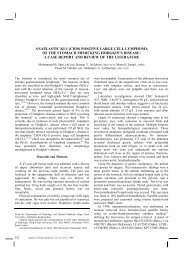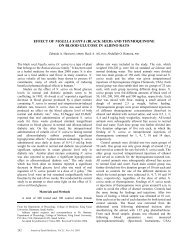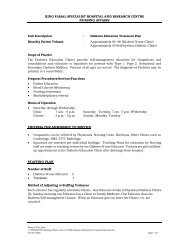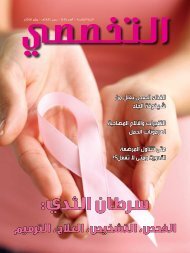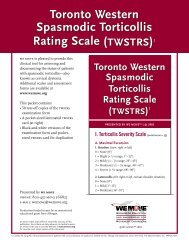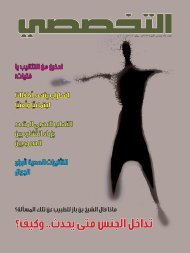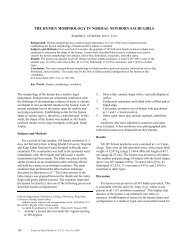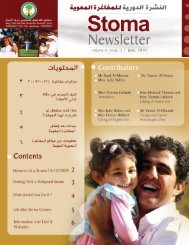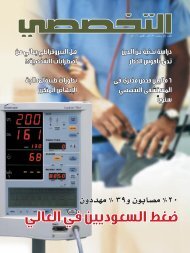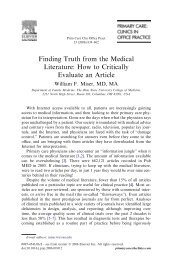A morpho-etiological description of congenital limb anomalies
A morpho-etiological description of congenital limb anomalies
A morpho-etiological description of congenital limb anomalies
You also want an ePaper? Increase the reach of your titles
YUMPU automatically turns print PDFs into web optimized ePapers that Google loves.
CONGENITAL LIMB ANOMALIESTable 1. Fetal causes <strong>of</strong> <strong>limb</strong> <strong>anomalies</strong>.Etiology/SyndromeNumber<strong>of</strong> casesLimb <strong>anomalies</strong>PresentationAssociated <strong>anomalies</strong>Chromosomal aberrations 9Trisomy 13 5 Postaxial polydactyly Holoprosencephaly, microcephaly,cleft lip/palateDuplication 13 (13q+) 1 Postaxial polydactyly Congenital heart, blepharophimosis,long philtrumTrisomy 18 1 Preaxial polydactyly Micognathia, clenched hands,protruded occiput, malformed ears,overlapping fingersCATCH 22 (22q-) 1 Postaxial polydactyly (F) Congenital heart, abnormal face,thymus hypoplasia, cleft palate,hypocalcaemiaTrisomy 21 1 Syndactyly 4th, 5th fingers Upward slanting palpebral fissures,low-set ears, depressed nasal bridge,hypotonia, mental retardationSingle gene disorders 30Isolated polydactyly (AD) 12 Polydactyly (F and/or T)Synpolydactyly (AD) 5 Synpolydactyly (F or T)Meckel-Gruber synd. (AR) 3 Polydactyly (F and/or T) Anencephaly, polycystic kidney, cleftpalateApert syndorome (AD) 2 Acrosyndactyly (F) Craniosynostosis, flat face, downslanting palpebral fissuresRadial ray defect (AD or AR) 2 Absent thumb, radial hypoplasia Ventricular septal defectFraser syndrome (AD) 1 Acrosyndactyly (F and T) Eyes covered by forehead skin, no eyelids, anal atresiaBardet-Biedl syndrome (AR) 1 Postaxial polydactyly (F and T) Obesity, retinal pigmentation,ventricular septal defectSyndactyly (AD) 2 Syndactyly (F or T)Split hand/foot syndrome (AD) 1 Absent middle finger, absent secondtoe, syndactyly 3rd and 4th toesTriphalangeal thumb polydactylysyndrome (AD)Total cases 39F=fingers, T=toes1 Triphalangeal thumb, preaxialpoldactylyAnn Saudi Med 25(3) May-June 2005 www.kfshrc.edu.sa/annals 221
CONGENITAL LIMB ANOMALIESFigure 1. Limb <strong>anomalies</strong> due to fetal causes (chromosomalaberrations).a) Bilateral cutaneous syndactyly <strong>of</strong> the little and ring fingers(arrow) and right little finger clinodactyly (arrow) in a short broadhand <strong>of</strong> a Down syndrome child (trisomy 21).b) Left preaxial polydactyly (arrow) in a newborn male withEdward’s syndrome (trisomy 18). Note the malformed low-set andposteriorly rotated ears, the micrognathia, the clenched hand,and the overlapping fingers.c) Left postaxial polydactyly (arrow) in a newborn male withpartial trisomy 13 (13q+). Other dysmorphic features includebulging forehead, blepharophimosis, deep-set eyes, depressednasal bridge, long philtrum, thin upper lip, and pectus excavatum.Figure 2. Showing <strong>limb</strong> <strong>anomalies</strong> due to fetal causes (singlegene disorders).a) Triphalangeal and distally displaced left thumb (short arrow)with thenar muscles hypoplasia, and preaxial polydactyly (longarrow) in an infant with the autosomal dominant triphalangealthumb polydactyly syndrome.b) Isolated preaxial polydactyly (arrow).c) Bilateral preaxial autosomal dominant synpolydactyly. Thesecond toe is duplicated and fused (arrows).224Ann Saudi Med 25(3) May-June 2005 www.kfshrc.edu.sa/annals
CONGENITAL LIMB ANOMALIEScases with Poland sequence and classified the hand<strong>anomalies</strong> into seven types according to severity <strong>of</strong>the deformity. Sirenomelia (vitelline artery steal) isanother example <strong>of</strong> vascular disruption leading toabnormal caudal development. 24 Five cases (7.1%) inthe present study suffered from <strong>limb</strong> <strong>anomalies</strong> dueto vascular disruption in the embryonic blood vessels.Vascular anastomoses and discordant placental bloodflow in twins with a common placenta predisposethem to vascular disruptions. In approximately 1%<strong>of</strong> monozygotic twins, intrauterine death <strong>of</strong> one twinmay result in release <strong>of</strong> thromboplastin or emboli tothe surviving co-twin leading to ischemia in localizedareas. 17 One patient in the present study hadgangrene and muscle atrophy <strong>of</strong> both lower <strong>limb</strong>s.He was one <strong>of</strong> a triplet. Other causes <strong>of</strong> vasculardisruption include placental infarction, maternal hypotension,vasoactive drugs, agents like cocaine andcertain medications. 17 e prenatal diagnostic technique,chorionic villus sampling (CVS), has also beenassociated with <strong>limb</strong> reduction defect, with anoxia <strong>of</strong>distal fetal structures as a postulated etiology. 39Infants <strong>of</strong> diabetic mothers have 6% risk <strong>of</strong> developing<strong>congenital</strong> malformations. e risk maybe over 20% if there is poor control during thefirst trimester. e malformations involve the heart(transposition <strong>of</strong> great vessels), anencephaly, spinabifida, holoprosencephaly, cleft lip and/or palate, renal<strong>anomalies</strong> and caudal regression sequence. 17 Onecase with caudal regression in the present study wasan infant <strong>of</strong> an uncontrolled diabetic mother.Twenty cases (28.6%) in the present study had<strong>limb</strong> <strong>anomalies</strong> as one <strong>of</strong> the manifestations <strong>of</strong> sporadicsyndromes (syndromes with unknown etiology).Acheiria (rudimentary hand and fingers) andaphalangia (transverse <strong>limb</strong> <strong>anomalies</strong>) are probablycaused by death <strong>of</strong> the mesenchymal cells in the <strong>limb</strong>bud region. 40 Ruiter et al 41 have described absent lefthand (a terminal transverse reduction defect) in aboy with mosaic trisomy 22. ey observed that thistype <strong>of</strong> <strong>limb</strong> <strong>anomalies</strong> has never been reported inassociation with this chromosomal aberration. isfinding points out the importance <strong>of</strong> genetics in thework-up in sporadic cases <strong>of</strong> <strong>limb</strong> <strong>anomalies</strong>.Watson 42 stressed that management <strong>of</strong> <strong>congenital</strong><strong>limb</strong> <strong>anomalies</strong> has to include classificationand etiology, incidence, diagnosis before birth,and counseling <strong>of</strong> parents. In a similar study doneby Holder-Espinasse et al 43 on 107 cases <strong>of</strong> <strong>limb</strong><strong>anomalies</strong>, the diagnosis was made in 78%, includingisolated, syndromic, or chromosomal <strong>anomalies</strong>with the conclusion that prenatal multidisciplinaryFigure 3 (a,b). Limb <strong>anomalies</strong> due to fetal causes (single genedisorders).A newborn boy with bilateral postaxial synpolydactyly <strong>of</strong> the ringfinger (short arrows) and bilateral preaxial synpolydactyly <strong>of</strong> thebig toe (long arrow).Figure 4 (a,b). Limb <strong>anomalies</strong> due to environmental causes.Limb <strong>anomalies</strong> due to amniotic band disruption: a) constrictionrings (arrow), syndactyly, and ectrodactyly or terminal phalangesamputations; b) Transverse <strong>limb</strong> defect, i.e. amputation <strong>of</strong> both feet.Ann Saudi Med 25(3) May-June 2005 www.kfshrc.edu.sa/annals 225
CONGENITAL LIMB ANOMALIESFigure 5. Limb <strong>anomalies</strong> due to environmental causes.a) A newborn with sirenomelia (due to vascular disruption)where both lower <strong>limb</strong>s and feet are fused, absent externalgenitalia and imperforate anus.b) A newborn with general vascular disruption presented withbilateral <strong>limb</strong> amputation (transverse reduction defect), absentright thumb and index finger, right radial hypoplasia (radial raydefect), absent external genitalia, and blue colored skin.c) Bilateral gangrene <strong>of</strong> the leg and foot due to abnormalcirculation in one <strong>of</strong> a triplet.Figure 6. Limb <strong>anomalies</strong> due to sporadic causes.a) Acheiria (transverse <strong>limb</strong> defect) in a newborn boy where theleft palm is absent and the fingers are rudimentary and presentedby digital buds (arrow), b) Tetraperomelia in a newborn boy(amputation in both upper and lower <strong>limb</strong>s), c) Bifid thumb.226Ann Saudi Med 25(3) May-June 2005 www.kfshrc.edu.sa/annals
CONGENITAL LIMB ANOMALIESassessment is fundamental to assist with counseling, asis the postnatal follow-up <strong>of</strong> the infant. e diagnosis,if made, will obviously influence the information thatwill be given to the parents and the management <strong>of</strong>the malformation, and guide recurrence risks.In conclusion, the <strong>etiological</strong> study, including thegenetic work-up, <strong>of</strong> <strong>morpho</strong>logically classified caseswith <strong>congenital</strong> <strong>limb</strong> <strong>anomalies</strong> is helpful in theprevention <strong>of</strong> many disorders causing <strong>limb</strong> defects.Prevention can be achieved via proper genetic counseling,which includes information on the etiology<strong>of</strong> the disorder (genetic or environmental), prenataldetection <strong>of</strong> <strong>limb</strong> <strong>anomalies</strong> and risk estimation forlater siblings.References1. O’Quinn JR, Hennekam RC, Jorde LB, BamshadM. Syndromic ectrodactyly with severe <strong>limb</strong>, ectodermal,urogenital, and palatal defects maps tochromosome 19. Am J Hum Genet. 1998;62(1):130-5.2. Giele H, Giele C, Bower C, Allison M. The incidenceand epidemiology <strong>of</strong> <strong>congenital</strong> upper <strong>limb</strong><strong>anomalies</strong>: a total population study. J Hand Surg[Am]. 2001;26(4):628-34.3. Zguricas J, Bakker WF, Heus H, Lindhout D,Heutink P, Hovius SE. Genetics <strong>of</strong> <strong>limb</strong> developmentand <strong>congenital</strong> hand malformations. PlastReconstr Surg. 1998;101(40):1126-35.4. Mathes SJ, Kerley SM, Manske PR, Upton JIII.Symposium: changing concepts in the management<strong>of</strong> <strong>congenital</strong> hand <strong>anomalies</strong>. ContempOrthop. 1993;27:481-04.5. Swanson AB. A classification for <strong>congenital</strong><strong>limb</strong> malformations. J Hand Surg. 1976;1:8-22.6. Smith JG, Weiss AC, Weiss YS. Congenital<strong>anomalies</strong> <strong>of</strong> the hand. Clin Pediatr. 1998;37:459-68.7. De Smet L. Classification for <strong>congenital</strong> <strong>anomalies</strong><strong>of</strong> the hand: the IFSSH classification and theJSSH modification. Genet Couns. 2002;13(3):331-8.8. Stoll C, Duboule D, Holmes L, Spranger J.Classification <strong>of</strong> <strong>limb</strong> defects. Am J Med Genet.1998;77:439-41.9. Luijsterburg AJ, van Huizum MA, ImpelmansBE, Hoogeveen E, Vermeij-Keers C, Hovius SE.Classification <strong>of</strong> <strong>congenital</strong> <strong>anomalies</strong> <strong>of</strong> the upper<strong>limb</strong>. J Hand Surg [Br]. 2000;25(1):3-7.10. Gurrieri F, Kjaer KW, Sangiorgi E, Neri G. Limb<strong>anomalies</strong>: Developmental and evolutionary aspects.Am J Med Genet. 2002;115(4):231-44.11. Hungerford GA. Leukocytes cultured fromsmall inoculo, the whole blood and the preparation<strong>of</strong> metaphase chromosomes by treatmentwith hypotonic potassium chloride. Stain Technol.1965;40:320-6.12. Seabright M. A rapid banding technique forhuman chromosomes. Lancet. 1971;ii:97-01.13. Mitelman F. ISCN- An International Systemfor Human Cytogenetic Nomenclature. Basle,Switzerland: Karger. 1995.14. McKusick VA. Mendelian inheritance in man.11th ed. Baltimore: The Johns Hopkins UniversityPress. 1996. Web site http://www.ncbi.nlm.nih.gov(updated weekly).15. Mueller RF, Young ID. Emery’s elements <strong>of</strong>medical genetics, 10th edition. Churchill Livingstone.1998.16. Jones KL. Smith’s recognizable patterns <strong>of</strong> humanmalformations, 4th edition. WB Saunders. 1988.17. Seashore MR, Wappner RS. Congenital malformations.In “Genetics in primary care & clinicalmedicine” Appleton & Lange ,NJ. 1996.18. Flatt AE. Genetics and inheritance. In: The care<strong>of</strong> <strong>congenital</strong> hand <strong>anomalies</strong>. St Louis: QualityMedical Publisher. 1994.19. Martinez-Frias ML Villa A, de Pablo RA,Ayala A, Calvo MJ, Bermejo E, Rodriguez L. Limbdeficiencies in infants with trisomy 13. Am J MedGenet. 2000;93(4):339-41.20. Sepulveda W, Treadwell MC, Fisk NM. Prenataldetection <strong>of</strong> preaxial upper <strong>limb</strong> reduction intrisomy 18. Obst Gynae. 1995;85(5):847-50.21. Kava MP, Tullu MS, Muranjan MN, Girisha KM.Down syndrome: Clinical pr<strong>of</strong>ile from India. ArchMed Res. 2004;35(1):31-5.22. Stempfle N, Huten Y, Fredouille C, Brisse H,Nessmann C. Skeletal abnormalities in fetuseswith Down’s syndrome: a radiographic post-mortumstudy. Pediatr Radiol. 1999;29(9):682-8.23. Tongsong T, Wanapirak C, Sirichotiyakul S,Sirivatanapa P. Prenatal sonographic markers <strong>of</strong>trisomy 21. J Med Assoc Thai. 2001;84(2):274-80.24. Sesgin MZ, Stark RB. The incidence <strong>of</strong> <strong>congenital</strong>defects. Plast Reconstr Surg. 1961;27:261-7.25. Packard DS, Levinsohn EM, Hootnick DR.Extent <strong>of</strong> duplication in lower-<strong>limb</strong> malformationssuggests the time <strong>of</strong> the teratogenic insult. Pediatrics.1993;91(2):411-3.26. Zguricas J, Snijders PJ, Hovius SE, HeutinkP, Oostra BA, Lindhout D. Phenotypic analysis <strong>of</strong>triphalangeal thumb and associated hand malformations.J Med Genet. 1994;31:462-7.27. Hensinger RN, Jones ET. Neonatal orthopaedics.New York: Grune & Stratton, Inc. 1981:191-09.28. Stelling F. The upper extremity. In: FergusonAB, Jr, ed. Orthopaedic surgery in infancy andchildhood. 5th ed. Baltimore: Williams and Wilkins.1981:709-45.29. Dobyns JH, Doyle JR, Von Gillern TL, CowenNJ. Congenital <strong>anomalies</strong> <strong>of</strong> the upper extremity.Hand Clinics. 1989;5:321-42.30. Temtamy S, McKusick V. The genetics <strong>of</strong> handmalformations. Birth defects. 1978;14:1-23.31. Qin W, Shu AL, Xing QH, Yang MS, Feng GY,He L. Genetic analysis <strong>of</strong> a Chinese pedigree with<strong>congenital</strong> synpolydactyly. Yi Chuan Xue Bao.2003;30(10):973-7.32. Riano Galan I, Fernandez Toral J, Garcia LopezE, Moro Bayon C, Mosquera Tenreiro C. Limbreduction defects in Asturias (1986-1997): prevalenceand clinical presentation. An Esp Pediatr.2000;52(4):362-8.33. Dastgiri S, Stone DH, Le-Ha C, Gilmour WH.Prevalence and secular trend <strong>of</strong> <strong>congenital</strong> <strong>anomalies</strong>in Glasgow, UK. Arch Dis Child. 2002;86(4):257-63.34. Simon NP, Simon MW. Congenital absence<strong>of</strong> the 5th digital ray and its proximal segmentalstructures. Am J Perinatol. 2003;20(1):7-10.35. Safarazi M, Akarsu AN, Sayli BS. Localization <strong>of</strong>the syndactyly type II (synpolydactyly) locus to 2q31region and identification <strong>of</strong> tight linkage to HOXD8intragenic marker. Hum Mol Genet. 1995;4:1453-8.36. Louis DS, Tsai E. Congenital hand and forearm<strong>anomalies</strong>. Curr Opin Ped. 1996;8:61-4.37. Al-Qattan MM. Classification <strong>of</strong> the pattern <strong>of</strong>intrauterine amputations <strong>of</strong> the upper <strong>limb</strong> in constrictionring syndrome. Ann Plast Surg. 2000;44(6):626-32.38. Al-Qattan MM. Classification <strong>of</strong> hand<strong>anomalies</strong> in Poland’s syndrome. Br J Plast Surg.2001;54(2):132-6.39. Thomas M, Chitayat D, Babul R, Wyatt P, WayeJS, O’Brien K, Chui DHK, Conacher S, Silver M. Alphathalassemia homozygotes and <strong>limb</strong> reductiondefects. Am J Hum Genet. 1994;55(3):A94.40. Ogino T. Congenital <strong>anomalies</strong> <strong>of</strong> the hand: TheAsian perspective. Cli Orth Rel Res. 1996;323:12-21.41. Ruiter EM, Toorman J, Hochstenback R, DeVries BB. Mosaic trisomy 22 in a boy with terminaltransverse <strong>limb</strong> reduction defect. Clin Dys<strong>morpho</strong>l.2004;13(2):99-02.42. Watson S. The principles <strong>of</strong> management <strong>of</strong><strong>congenital</strong> <strong>anomalies</strong> <strong>of</strong> the upper <strong>limb</strong>. Arch DisChild. 2000;83(1):10-7.43. Holder-Espinasse M, Devisme L, Thomas D,Boute O, Vaast P, Fron D, Herbaux B, Puech F,Manouvrier-Hanu S. Pre-and postnatal diagnosis<strong>of</strong> <strong>limb</strong> <strong>anomalies</strong>: a series <strong>of</strong> 107 cases. Am J MedGenet A. 2004;124(4):417-22.Ann Saudi Med 25(3) May-June 2005 www.kfshrc.edu.sa/annals 227



